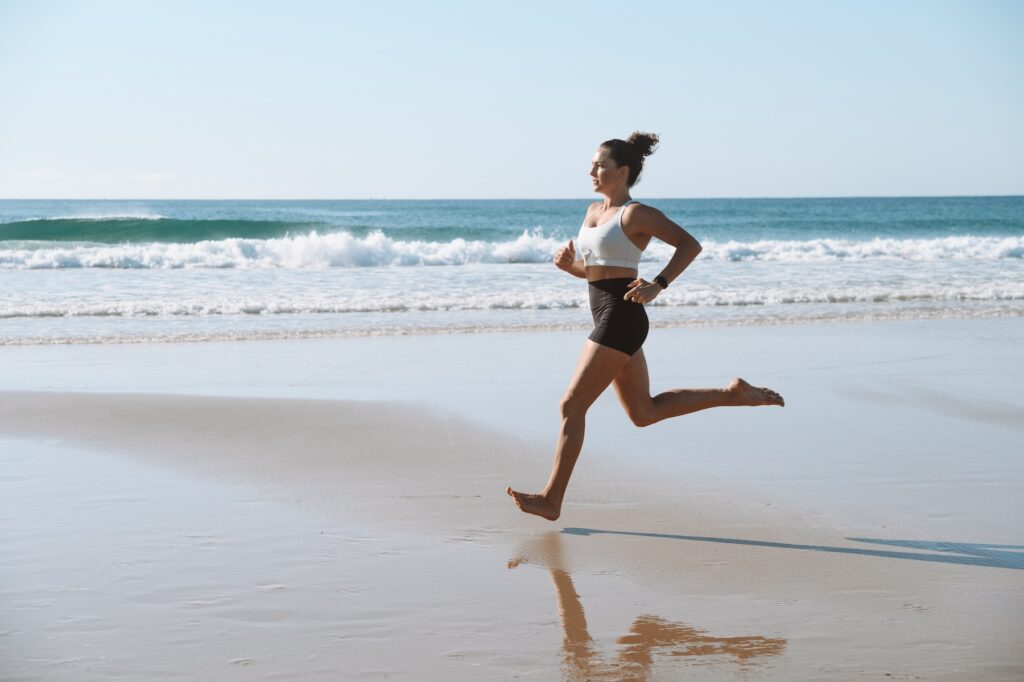Running is more than exercise—it’s your headspace, your release, your freedom.
But if you’re experiencing leaks, heaviness, or discomfort, it’s not because you’re broken. It’s your body’s way of asking for support.
Your pelvic floor plays a vital role in absorbing impact and managing pressure as you move. And the good news? With the right strategies, you can train smarter, build strength, and run with confidence again.
Let’s break down how to protect your pelvic floor on every run—backed by research, not just trends.

Why Running Impacts the Pelvic Floor
Running is a high-impact activity. Research shows the body absorbs up to 2.5x your body weight with each step. These repeated braking forces increase stress up the legs and pelvis.
If your body isn’t absorbing impact efficiently, that stress translates into excess intra-abdominal pressure—which puts a direct load on your pelvic floor.
The pelvic floor is a group of muscles and connective tissue at the base of your pelvis, responsible for:
- Supporting internal organs (bladder, uterus, and rectum)
- Regulating intra-abdominal pressure
- Controlling bladder and bowel function
- Enhancing sexual function
- Supporting blood flow and movement efficiency
When these muscles are weak, overly tight, or uncoordinated, they can struggle to do their job—leading to leaks, heaviness, and pain.
Research reference: During running, the body absorbs up to 2.5x its body weight per step. PubMed
How to Protect & Support Your Pelvic Floor While Running?
1. Master Your Breath
Your diaphragm and pelvic floor are a team—like two trampolines stacked on top of one another. For them to function well, they need the right balance of tension, flexibility, and timing.
If you’re breath-holding or breathing shallowly, you’re increasing downward pressure on your pelvic floor—leading to fatigue, tension, and symptoms like leaking or pain.
Studies show that coordinating breath with pelvic floor activation improves function and pressure control.
PubMed
Try this before your run:
- Inhale through your nose (360° rib expansion), allowing the pelvic floor to relax and lengthen
- Exhale gently through your mouth, like blowing out candles—allowing the pelvic floor to lift
- Repeat 5–10 times pre-run
2. Shorten Your Stride
A long, overreaching stride increases ground force and pelvic floor load. Instead:
- Slightly shorten your stride
- Lean gently forward from the ankles
- Keep your foot strike under your center of mass
Ideal cadence: 170–180 steps per minute
Tip: Use a playlist or metronome app to help stay on rhythm.
3. Choose the Right Footwear
Your shoes are your foundation. The right pair can reduce impact and keep stress off your pelvic floor.
Look for:
- Shock absorption
- Arch support
- A wider toe box (your feet are deeply connected to your pelvic floor via fascia)
Watch for my upcoming blog on best running shoes for pelvic floor support!
4. Build Strength Between Runs
Pelvic floor dysfunction is often a coordination issue as much as a strength issue. Training it with your breath, core, glutes, and adductors is key.
Strength training with breath-focused pelvic floor engagement improves continence and impact absorption.
PMC Study
Try these movements:
- Breath-to-movement squats
- Bridges with pelvic floor lift
- Bird-dogs for core stability
- Core marches on the exhale
5. Listen to Your Body—Without Fear
Leaking isn’t something you should just accept. And it’s not a reason to stop running. It’s your body’s signal—not a limitation.
Whether you’ve had children or not, your pelvic floor deserves support. And with the right strategy, you can rebuild strength and confidence.
Running and pelvic floor health don’t have to be in conflict. With intentional breathwork, smarter strength training, and a supportive plan, you can run longer, stronger, and leak-free.
Want a Step-by-Step Plan?
Pelvic Floor Strength for Running is a proven 8-week program designed to help you:
✔ Heal leaking & pelvic pain
✔ Retrain your breath & rebuild deep core strength
✔ Follow a running progression that protects your pelvic floor and builds confidence
Join 1,000+ women returning to running without fear.


